Streamlining enterprise sales in digital health
For digital health startups, it’s increasingly a B2B world—and innovators are acutely feeling the challenges of enterprise sales. Selling to payers, providers, biopharma companies, and others is a tough game across the board. Sales cycles are long, requiring patience and a knack for relationship building. Finding the right buyer in a big organization can be disorienting. And crafting the pitch is tricky when talking to a complex, multi-faceted enterprise customer.
Startups employ a range of tactics to address these challenges—including pilots, creative partnerships, and business model pivots. With so many choices in a complicated landscape, it’s worth asking: What’s working? And why? What can be learned from entrepreneurs conquering enterprise sales? And what insights can enterprise buyers share (and learn) from the other side of the table?
To answer these questions, we conducted primary research with 85 digital health founders and numerous enterprise healthcare leaders to uncover the tactics successful startup teams employ to close enterprise deals.
Our methodology
This report is the product of contributions from 85 digital health startup founders. Through their initial survey1 responses, we established a baseline of information on enterprise sales through the eyes of entrepreneurs. Our survey was not intended to be exhaustive. Rather, it served as a way for us to identify strong signals to inform more in-depth interviews2. We then conducted interviews with a mix of over 15 startup CEOs and executives from enterprise healthcare companies who shared their candid “lessons learned” from experiences with startup-enterprise sales3.
These data and interviews helped narrow our focus to three key questions for understanding successful B2B business practices in digital health:
- What type of relationship do enterprise customers want with startups—and how should startups approach potential customers?
- What are pilots for—and are they being used correctly?
- Healthcare sales cycles are long. How can startups get their pitches to the right enterprise buyers quickly?
What follows is a summary of key findings and valuable insights from subject matter experts—startup CEOs and enterprise healthcare company leaders.
How to approach the enterprise healthcare customer relationship
Know the (startup) competition
From entrepreneurs
CEOs from our survey solidly felt that knowing “who our competitors are targeting” was not a factor in closing deals. They ranked it the least important of seven factors for qualifying leads in their target market (with only 14% ranking it “Very” or “Extremely” important in qualifying leads). Just 5% responded that it “Strongly” or “Extremely” hindered closing deals.
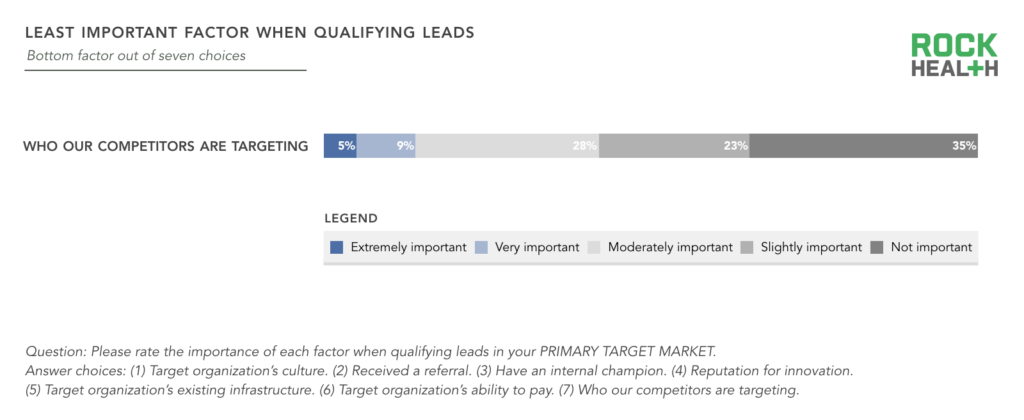
Source: Rock Health Enterprise Sales in Digital Health Survey 2017
From the enterprise
However, this sentiment did not align with feedback from enterprise buyers. They noted that startups who pitch them often fail to realize they exist in a potentially crowded space. Enterprise buyers want—and expect—startups to demonstrate differentiated offerings from the customer’s perspective.
Bruce Brandes, CEO & Founder of Lucro, notes that “there are [many competitors] with the same message.” He advises startups to craft their pitch and “tune out the noise of what’s not relevant [to your unique value proposition] and align [the customer to] what your priorities are.”
Pro Tip
Startups should assume their enterprise customers know the competitive landscape (even if they don’t let on!). Differentiating a startup’s offering among competitors will strengthen the credibility of the product and sales pitch.
Make your customer feel special
Every customer wants to feel unique; no one wants a “one size fits all” pitch. Though this sounds obvious, enterprise buyers expressed concerns. In fact, startups shared that they may not be tuning the pitch to each buyer.
From the enterprise
Several enterprise buyers felt that startups approach them with insufficient knowledge about their priorities, challenges, or knowledge of their organization’s role.
50% of startups are not well prepared and about 25% are really well prepared.
Daniel J. Gandor, Director of Digital Innovation and Corporate Program Management at Takeda
Some startups haven’t done any research. Like with any publicly traded company, we have an analyst day. If you can link your pitch to that presentation you will hit 90% of what we are looking for. Or they could [take an] hour to read our annual report. That’s an easy way to understand the basics.
Enterprise healthcare company
Startups get gung-ho about a payer partner, yet they’re pitching to so many other organizations instead of focusing on a few and hitting it out of the park. Startups can better focus on deeper engagements with potential partners than spreading themselves thin.
Laika Kayani, Director of Health Innovation Product Strategy at Blue Shield of California
The key to personalizing an approach is learning about the customer. But how much research to do—and how to go about doing it?
From entrepreneurs
Among our survey respondents, 46% of startup CEOs performed “extensive” or “a lot of”
research on prospective customers before approaching them for the first time (with 54% doing “very little” or just “moderate” research). Bearing in mind that surveyed CEOs are among those who are succeeding to varying degrees, we hypothesize that struggling or failed startups perhaps face even greater challenges getting “smart” about their potential customers.
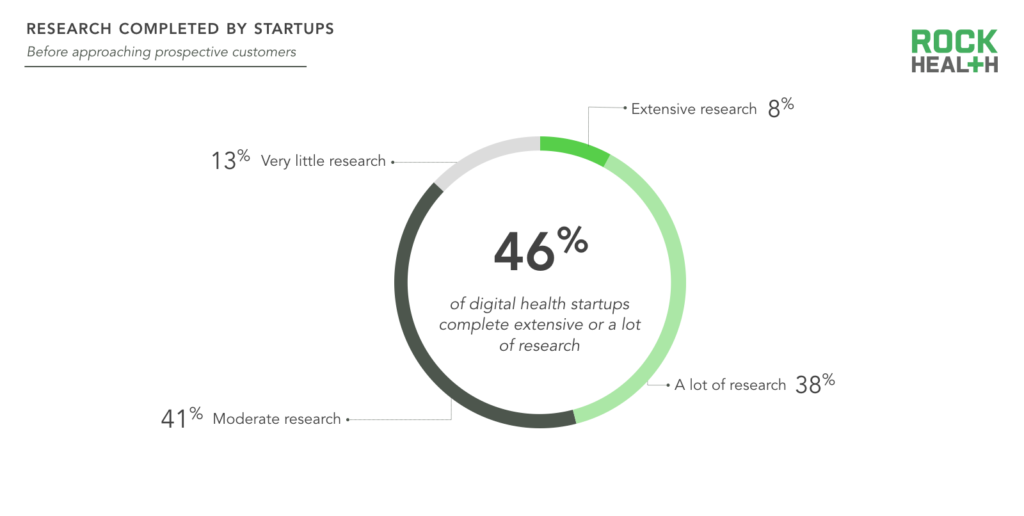
Source: Rock Health Enterprise Sales in Digital Health Survey 2017
Pro Tips
It’s not always possible to prepare as much as desired, and “inside” information on buyers can be hard to come by. With that in mind, at the point in the sales funnel where live customer interactions and presentations are made, startups should:
- Prioritize well-researched quality interactions over quantity.
- Read the most recent SEC filings and familiarize themselves with the customer’s product portfolio.
- Carefully review the LinkedIn profile for every customer on the sales call.
Success by pilot
Though “death by pilot” is a commonly cited pitfall in digital health, our survey respondents had mostly succeeded with their pilots. Among startups who responded to our survey, almost 70% of pilots converted to paying customers. Here’s why and how they achieved success.
Benchmarking timelines
We asked CEOs to divulge how long it took to get from the verbal “handshake” closing the deal to their first active user in the pilot. About 69% of pilots had an active user within six months of the “handshake.” Another 20% of pilots took between seven months and one year to engage their first user after the deal was made.

Source: Rock Health Enterprise Sales in Digital Health Survey 2017
The pace of onboarding is mixed, however, and depends heavily on the product as well as the customer segment. One CEO who sells to insurers reported, “Generally it’s at least 18 months to contract with a health plan—six months generating interest or a pilot, a couple months to find an executive sponsor and business owner to push it through, six to eight months for a technical security assessment, and four to six months for contracting. But even when you launch and have a contract it doesn’t mean they’re ready to implement—it could just mean you are in a queue.”
Multiple CEOs reported that when a pilot takes too long or when too many are attempted, the pursuit of pilots dilutes a founder’s efforts. Tom White, CEO of Phynd, even said, “We’ve historically never done pilots […] If you’re going to do pilots, I think doing one or two is fine, but make sure they convert into cash. Otherwise, pitching a pilot versus a sale is just diluting your efforts.”
Paid vs. Unpaid
The findings here were fairly clear, and the news is good: Among the startups we surveyed, between 60-70% of pilots convert to full customers. Moreover, there was little difference among those pilots in which the customers paid and those who did not. At least one CEO even encouraged startups to price pilots higher than the cost of a customer license, pointing out that this creates aligned incentives.
Pro Tip
Apart from that first, essential pilot needed to get off the ground, strategically time-box the pilot pitch process for subsequent pilots. As the product matures, the risk-benefit tradeoff shifts in favor of more aggressively pursuing sales instead of pilots. Finally, absolutely pursue paid pilots, but don’t sweat it too much if you’ve got a potentially strategic customer on the line for an unpaid pilot.
Clear, aligned goals
CEOs and founders can be tempted to oversell their product before it’s fully ready to go. One CEO who was successful in acquiring enterprise customers flat out said, “I sold it like it was real”—even when it wasn’t. Pursuing this strategy involves a calculated risk, and this CEO was prepared to make it “feel” real until it was. In that vein, 39% of CEOs in our survey approached customers for a pilot before their minimum viable product (MVP) was ready.
A word of caution: this strategy can easily backfire. One healthcare company told us, “We want commercially viable solutions. A lot of startups are pitching us when they don’t even have a working prototype. […] We want something that solves our pain points and scales fast. A lot of startups aren’t ready for rapid growth even if the pilot goes well.”
Rather than preemptively selling a product that’s not ready for prime time, startups can instead make a customer a co-developer so long as they have the right approach—and the right partner. One enterprise healthcare company with interest in this type of partnership said, “Startups are often looking for validation on their product concepts rather than pitching a developed and well-vetted product. I’d rather someone ask if they can pick my brain and get perspective on how to build their product so it solves a problem. We often want to work with startups on their product. They shouldn’t oversell and overcommit capabilities they don’t have.”
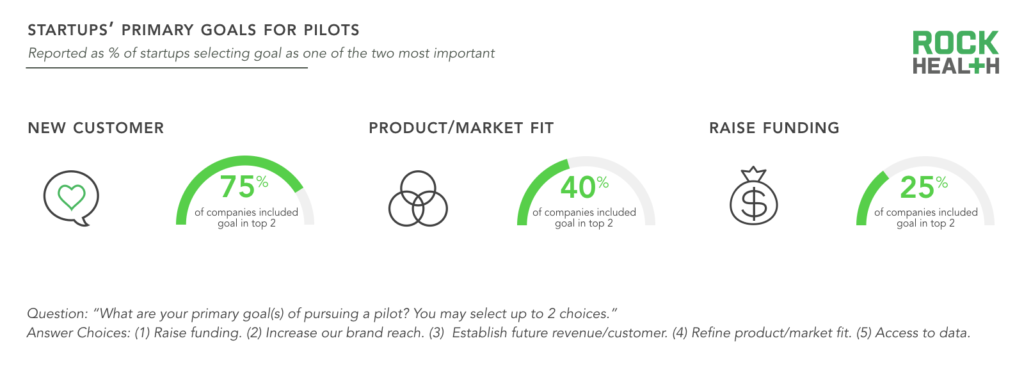
Source: Rock Health Enterprise Sales in Digital Health Survey 2017
Regardless of the pilot path taken—whether a pilot with an MVP or a co-development partnership—err on the side of over-communication.
[We succeed by] being really focused on communicating our progress and [if something goes wrong] what the resolution is. We ran two calls a week every week, even when there were only small items to discuss. And that has gone a long way towards building a strong foundation.
Dan Wilson, CEO of Moxe
Pro Tips
- If the product is “pre-MVP,” strongly consider exploring the enterprise customer’s interest in co-development during the pilot pitch process.
- Ensure both parties are aligned on goals and expectations for the pilot.
- Communicate weekly milestone-driven progress updates and clear follow-up on issues.
Accelerating enterprise sales (in healthcare)
Find the buyer
In our survey we asked startup CEOs to rate the difficulty of each step of a full sales cycle. They rated finding the appropriate buyer as the most difficult stage5. And when we asked about factors that help close deals, CEOs overwhelmingly felt an internal champion was “extremely important” to securing a sale. Taken together, these data points pointed to the same theme: Finding that “special someone” is both the key challenge and key to (speedier) success.
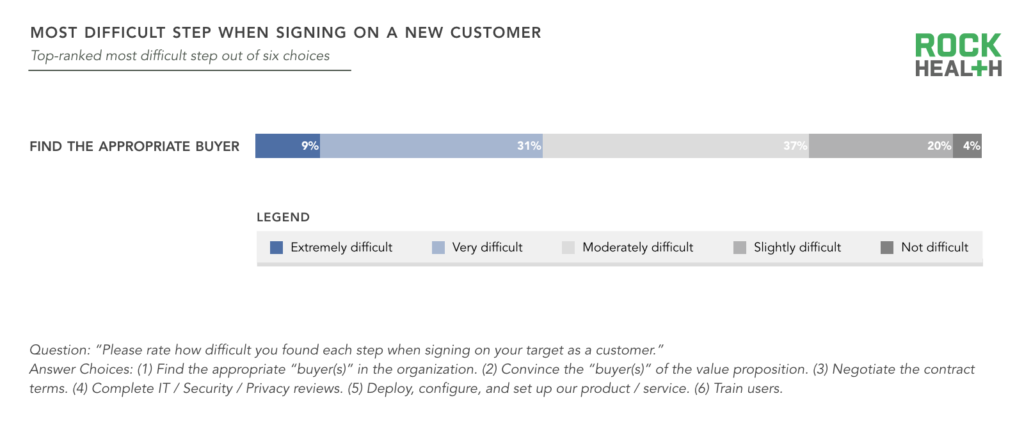
Source: Rock Health Enterprise Sales in Digital Health Survey 2017
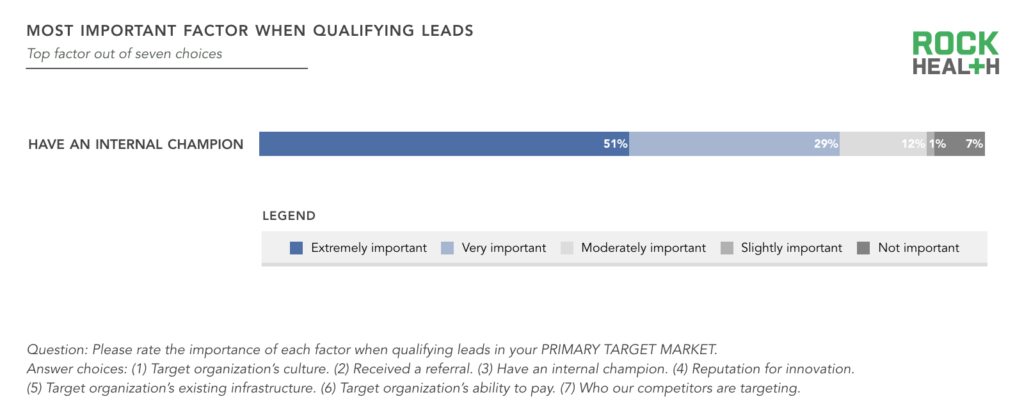
Source: Rock Health Enterprise Sales in Digital Health Survey 2017
Occasionally, an internal innovation team exists to help facilitate this process. One CEO shared his strategy of developing relationships directly with the line-of-business end-customer in addition to employing the innovation team. Doing so helps the startup learn the organization more quickly and complements the innovation team’s efforts. Often, the innovation team is actively looking for engagement and coordination with startups.
Invest in presentation and marketing materials
We talked with multiple enterprise buyers who reported that startup marketing materials too often fail to tell a story that resonates or are not developed in a way that helps them socialize the startup’s value proposition among colleagues. A polished presentation and crisp storytelling make a real difference.
Bruce Brandes, CEO & Founder of Lucro told us, “How a startup tells their story affects their outcomes. We’ve found that 90 to 120 second videos work really well. [Written] descriptions need to be 200 characters or less or buyers won’t read them.”
Daniel J. Gandor, Director of Digital Innovation and Corporate Program Management at Takeda shared: “One thing I prefer is for startups to have their materials pre-packaged in a way that tells the story quickly, is easily understood by all, and is shareable through email. Do not expect people to navigate around special websites, watch long videos, or wade through complex materials. At the end of the day, many large corporations still speak the language of Powerpoint, so sending a slide-based PDF overview can work great.”
Decisions within the enterprise typically require alignment among multiple stakeholders. By supplying marketing materials that facilitate this process, startups help the prospective corporate buyer gain alignment more quickly.
In conclusion
The rumors are true: B2B business models predominate digital health. Of the startups we surveyed, 34% began life with a B2C business model. Of those who started as B2C companies, 61% changed their business model to either B2B2C (45%) or B2B (16%). Only 14% of companies surveyed currently employ a B2C business model6. It’s a B2B world.
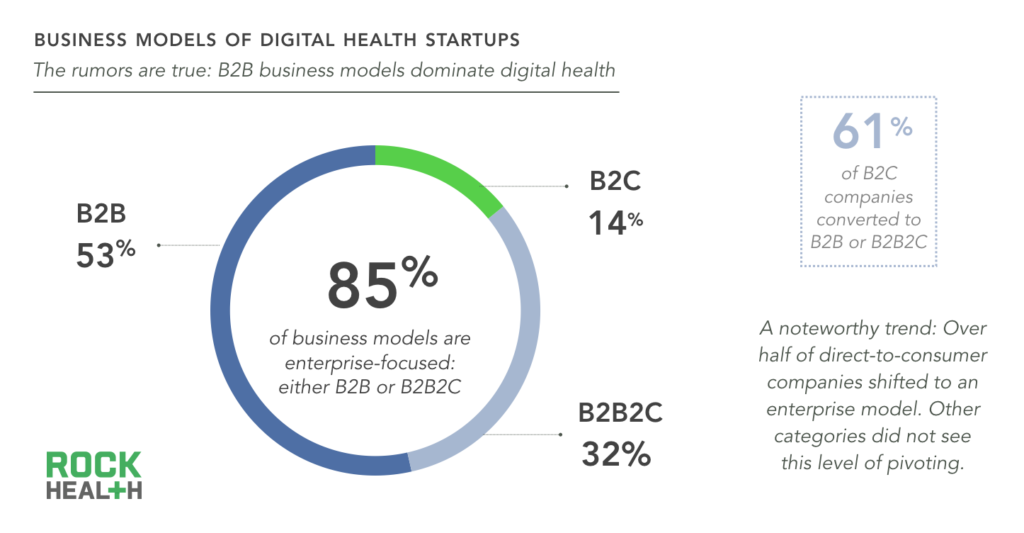
Source: Rock Health Enterprise Sales in Digital Health Survey 2017
Despite the hurdles of the B2B business model in digital health, the challenges can be matched with proven tactics that will accelerate the sales process—and the path to success as a startup. Execution on these tactics may not be a guarantee of future success, but success will be much harder to come by without them!
Acknowledgements
Rock Health is committed to learning from and educating our community in pursuit of our mission to massively improve healthcare for every human being. The wisdom and insights in this report come from the many, generous contributions of the CEOs and enterprise executives we’ve listed below. We are humbled every day by our community’s many contributions to our and each other’s success. Any and all mistakes are our own.
Thomas White, CEO of Phynd
Manik Bhat, CEO of Healthify
Joe Novello, CEO of NurseGrid
Abhas Gupta, CEO of Calyx Health
Adnan Iqbal, CEO of Luma Health
Dan Wilson, CEO of Moxe Health
Rodrigo Martinez, CMO of VeritasGenetics
Joel Wish, CEO of Simple Contacts
Helena Plater-Zyberk, CEO of SimpleTherapy
Corey Centen, CEO of Bodyport
Jeffrey Brewer, CEO of Bigfoot Biomedical
Katherine Chambers, CEO of The Right Place
Dongxue Wang, Head of International Corporate Development of MoreHealth
Brad Hirsch, CEO of Signal Path
Laura McKee, CEO of Autism Home Support
Tom Spann, Founder and Vice Chair of Accolade Security
Alex Frommeyer, CEO of beam
Allen Berning, CEO of Ambient Clinical Analytics
Erin Landau, Program Manager at Ovia Health
Colt Stander, CEO of Clutch
David Ehrlich, CEO of Aktana
Jordan Epstein, CEO of Stroll Health
Jeffrey Margolis, CEO of Welltok
Julia Cheek, CEO of Everlywell
Piraye Yurttas Beim, CEO of Celmatix
Jared Heyman, CEO of Crowdmed
Robert Herzog, CEO of eCaring
Gary Slagle, CEO of Agile Health
Borna Safabakhsh, CEO of AgileMD
Teddy Cha, CEO of PulseData
Alan Levy, CEO of Chrono Therapeutics
Mike Baird, CEO of Avizia
Mark Frank, CEO of Sondermind
Sajith Wickramasekara, CEO of Benchling
Denny Weinberg, CEO of Hixme
Yael Katz, CEO of BrainCheck
Matteo Lai, CEO of Empatica
Ralph Derrickson, CEO of Carnamd
Oakkar Oakkar, CEO of Keona Health
Patrick Anquetil, CEO of Portal Instruments
Brenda Schmidt, CEO of Solera Network
Bruce Brandes, CEO of Lucro
Khizer Khaderi, CEO of Vizzario
Daniel J. Gandor, Director of Digital Innovation and Corporate Program Management at Takeda
Laika Kayani, Director of Health Innovation Product Strategy at Blue Shield of California
We would also like to thank the many individuals from our corporate partners who gave us their time—from Abbvie, Accenture, Boehringer Ingelheim, Boston Children’s Hospital, CVS Health, DaVita, Sanofi, and Sutter Health.
Footnotes
1Forty-nine questions were asked in an online survey designed to take approximately 15 minutes to complete. Survey responses were gathered between April 3rd and April 24th.
2Research of this sort suffers from inherent survivorship bias, and as a result firm conclusions should not be drawn from the data alone. Survey results informed the follow up questions we most needed to ask startup CEOs and enterprise healthcare buyers.
3Subject matter expert interviews were conducted between April 4th and June 29th, 2017 through a mix of email and 30-minute phone interviews.
4Other choices included convincing the buyer of the value proposition, negotiating terms, gaining internal approvals (security, compliance, and IT), deploying and setting up the product, and training users (before launch).
5When analyzing the data for insights into B2B trends, we first removed the 14% respondents who indicated that they currently employ a B2C business model.

